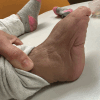Advanced Management of Distal Lower Extremity Congenital Constriction Bands for Foot Salvage
- PMID: 39296613
- PMCID: PMC11410327
- DOI: 10.1097/GOX.0000000000006181
Advanced Management of Distal Lower Extremity Congenital Constriction Bands for Foot Salvage
Abstract
Constriction ring syndrome is a rare congenital condition characterized by the formation of fibrous amniotic bands, which can result in limb or digit deformation, malformation, or autoamputation. Surgical intervention is necessary for patients with progressive or severe forms of constriction banding, but the timing and operative approach vary widely. Here, the authors present a case report detailing the successful removal of multiple congenital constriction bands (CBs), uniquely affecting the distal ankle and foot in an infant meeting Patterson type-2 criteria. This type is characterized by CBs resulting in distal deformation with or without swelling. In this case, urgent intervention was prompted by concerns of vascular compromise, and amputation was considered due to the severity of the banding. However, the authors advocated for a staged approach, with the aim of preserving the patient's limb. A series of three separate procedures tailored to the patient's banding pattern and subsequent tissue complications were required to achieve restoration of ankle and foot functions, as well as satisfactory cosmesis. This case report underscores the importance of a customized surgical approach in addressing complex CBs and emphasizes the need for proactive consideration of salvage interventions by surgeons.
Copyright © 2024 The Authors. Published by Wolters Kluwer Health, Inc. on behalf of The American Society of Plastic Surgeons.
Conflict of interest statement
The authors have no financial interest to declare in relation to the content of this article.
Figures




References
-
- Inglesby DC, Janssen PL, Graziano FD, et al. . Amniotic band syndrome: head-to-toe manifestations and clinical management guidelines. Plast Reconstr Surg. 2023;152:338e–346e. - PubMed
-
- Singh AP, Gorla SR. Amniotic band syndrome. In: StatPearls [Internet]. Treasure Island, Fla.: StatPearls Publishing; 2024.. Available from: https://www.ncbi.nlm.nih.gov/books/NBK545283/. Accessed August 13, 2024. - PubMed
-
- Koskimies E, Syvänen J, Nietosvaara Y, et al. . Congenital constriction band syndrome with limb defects. J Pediatr Orthop. 2015;35:100–103. - PubMed
-
- Chan AHW, Zeitlinger L, Little KJ. Multiple continuous Y-to-V-plasties for excision and reconstruction of constriction band syndrome: case series and description of surgical technique. Plast Reconstr Surg. 2022;149:774e–778e. - PubMed
-
- Habenicht R, Hülsemann W, Lohmeyer JA, et al. . Ten-year experience with one-step correction of constriction rings by complete circular resection and linear circumferential skin closure. J Plast Reconstr Aesthet Surg. 2013;66:1117–1122. - PubMed
Publication types
LinkOut - more resources
Full Text Sources
